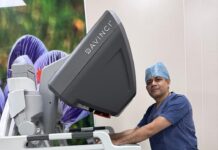Cancer continues to rage on in India as in other Asian countries. India stands highest is lip and cavity cancers, second in breast and cervical cancers. The Indian Cancer Society strongly believes that “Many Cancers are treatable, when detected early.” Hence early stage diagnosis has become one of the major concerns for India in the last decade. Special clinics are getting established that specialize in rapid and precise investigations. Hospitals are ramping up their diagnostic labs with advanced diagnostic tools and AI machines for clear imaging and pathological investigations. Early detection of cancer increases the chances of successful treatment and better survival rate.
In an interview with The Indian Practitioner, Dr. Srinivas Chilukuri, Senior Consultant for Radiation Oncology (Paediatrics, Urology and Thoracic) of Apollo Proton Cancer Centre shares his expertise in advanced diagnosis of various cancers. Dr Chilukuri contributed significantly to establishing RapidArc, IGRT, SRS and SBRT programme at Yashoda Cancer Institute (YCI). He was instrumental in establishing and running Varian School for High Precision Radiotherapy (in collaboration with Varian Medical Systems), which has till date trained more than 220 radiation oncologists and physicists across the Indian subcontinent.
The Indian Practitioner (TIP): Dr. Srinivas, you have been the clinical lead for advanced radiation therapy school and have trained more than 200 radiation oncologists from the Indian subcontinent, what is your view on the current scenario of cancer diagnosis in India?
Dr. Srinivas (Dr. S): Most cancers are diagnosed after a cross-sectional imaging and a guided biopsy of the tumor. Both radiology and pathology remain the pillars for diagnosing cancers. Advances in radiology and pathology have paved way for advanced diagnostics which has led to improvement in our understanding of individual cancers. This individualization has enabled the field of precision medicine.
TIP: Could you please elaborate on the advancements in Radiology?
Dr. S: Virtual endoscopies and image processing have enabled relatively minimally invasive diagnostic biopsies from difficult/challenging sites. Higher resolution images: 3T MRI images, 640 slice CT scanners, images with artefact reduction, physiological imaging in-built on cross sectional imaging have enabled picking up of early tumours, early recurrences and thereby leading to improved outcomes. PET scanners with several innovative PET tracers which give a sneak peak in to the tumour physiology have enabled optimizing treatments with either intensification or de-intensification of treatments. Various PET tracers also allow precision medicine treatments for various cancers including theranostics. AI/ML in radiology to enable wider access to expert radiology services, potentially improving the accuracy and turnaround times of the radiology reporting.
TIP: What is molecular pathology? How does it help in cancer therapy and how has it changed the pathological reporting scenario?
Dr. M: Most cancers are now classified based on molecular markers, each with a potential to be treated with targeted therapies. These are not just relevant at a diagnostic level, but also to prognosticate and predict the responses with potential targeted agents. High throughput Next generation sequencing- High throughput NGS methods are now able to sequence DNA and RNA accurately to unravel the molecular biology of various cancers. This has improved our understanding of cancer biology to a great extent. AI/ML in pathology including digital pathology- Very similar impact as noted in radiology such as improving access to advanced expertise, improving accuracy and throughput of the pathology reporting.
TIP: Prostrate cancer is one of the top 10 cancers in India. Earlier it was more prevalent among men above 65 years, but recently there has been an increase in reports of cancer in younger menn the age group of 35-44 residing in metropolitan cities. What advance treatment do you recommend for prostate cancer?
Dr. S: A key advance in the treatment of prostate cancers has been the emergence of newer hormonal agents. Newer hormonal agents such as Abiraterone, Enzalutamide, Darolutamide, etc. have improved outcomes to a great extent not just in metastatic prostate cancers but also in locally advanced prostate cancers. Most of these agents target Androgen receptor mediated resistance mechanisms to ADT and thereby prolong the survival. Since most of these drugs are oral agents, patients find it convenient to take these drugs without the need for admission and extensive supportive care. Some of the early evidence hints that addition of these drugs does not significantly alter/worsen the quality of life of patients compared to other standard therapies.
TIP: Immunotherapy currently is not perceived as a cancer cure, but it only helps to prolong life of patients. Please tell us something about immunotherapy? And what is the quality of the life of patients who are treated with immunotherapy?
Dr.M: Immunotherapy in cancer targets the body’s own immune system to act against the tumors. Immunotherapies seek to activate or reactivate the immune system to attack and destroy cancer cells that have escaped immune detection. There are several types of immunotherapy that are approved by the FDA or are under study (in clinical trials) to determine their effectiveness in treating various types of blood cancer. Potential of immunotherapy was unravelled not so long ago and we now have multiple drugs called check point inhibitors, vaccines, monoclonal antibodies, etc which are usually safe in a variety of patients and have shown some dramatically good results. For example, addition of a drug called Durvalumab in addition to standard chemoradiation for patients of stage 3 lung cancers have significantly improved outcomes.
TIP: What is CAR T-cell therapy? Could this therapy be the game changer in cancer treatment?
Dr. S: In CAR T-cell therapy, a patient’s own T cells are collected and biomodified by genetic engineering to develop specific receptors. The T lymphocytes which have these chimeric antigen receptors. The CAR T cells which are bioengineered are injected in to the patient and these cells recognise and attack cancer cells with the specified antigen on their surfaces. This therapy has shown some dramatically promising results in some of the blood related malignancies. Various trials are now testing the safety and efficacy of this therapy in various cancers.
TIP: Lastly, could you please explain how to mitigate the side effects of radiation etc.?
Dr. S: Prevention of side-effects is always better than managing side-effects once they appear. Therefore field of radiation oncology has focussed itself to minimize the doses to normal healthy structures while delivering adequately high doses to tumours. Major advances in the field of radiation oncology such as intensity modulated radiation therapy (IMRT), image guided radiation therapy (IGRT), VMAT, stereotactic radiotherapy and radio surgery are all steps in the same direction.
Proton therapy- among the various advances in the field of radiation therapy and oncology, proton therapy is considered the most sophisticated form of radiation therapy which enabled delivery of high doses to the tumour and completely avoiding any dose (including sometimes zero dose) to the adjacent structures. This can have tremendous impact on long term toxicities in various cancer patients. Proton therapy is not only useful in challenging childhood cancers, brain tumours, bone and soft tissue and skull base tumours but also for more common cancers of head neck, lung, breast and prostate. The probability of long term side effects such as organ dysfunction, physical deformities, organ dysfunction, fertility issues, neuro-cognitive loss, vasculopathy, second cancers, etc are considerably less with proton therapy compared to conventional radiation therapy techniques such as IMRT, IGRT, VMAT and SRT.
There are several drugs and supportive treatment available when patients develop long term effects of treatment. Drugs which target vascular endothelial factor receptor have led to reduction in the long-term adverse effect of radiation on brain. Similarly, potent anti-emetics, blood products, safer analgesics, etc. have improved supportive care of patients with cancers and mitigate the effects of radiation and chemotherapy.

























